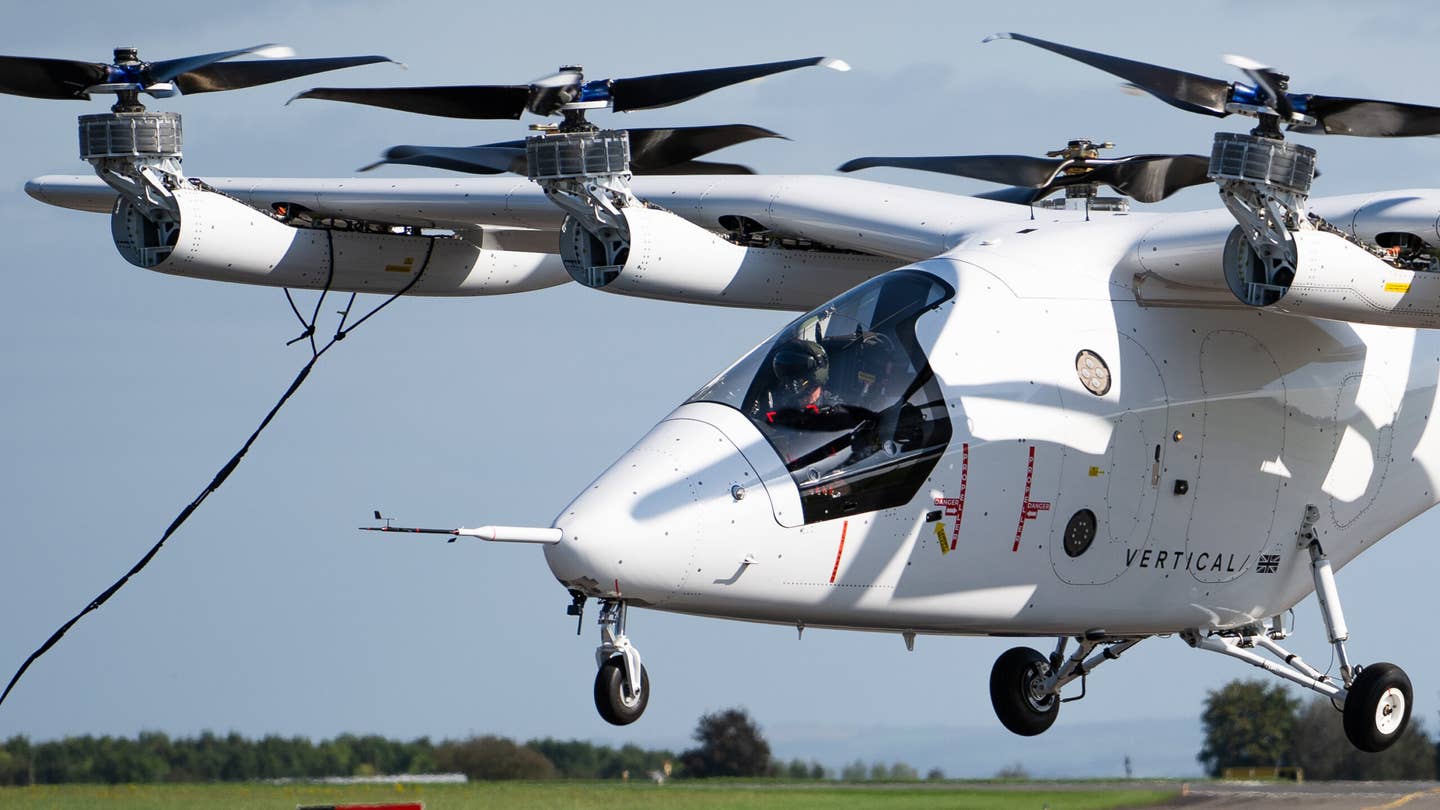Vertical Completes First Phase of Testing With New Air Taxi Prototype
U.K. manufacturer took a prototype of its flagship VX4 through ground testing and multiple crewed tethered flights at Cotswold Airport.

Vertical Aerospace conducts piloted flights of its VX4 air taxi while the aircraft is tethered to the ground. [Courtesy: Vertical Aerospace]
U.K.-based electric vertical takeoff and landing (eVTOL) air taxi manufacturer Vertical Aerospace on Thursday said it wrapped up the first of four phases of crewed testing with a prototype of its flagship VX4, a piloted design for up to four passengers.
At the company’s flight test center at Cotswold Airport (EGBP) in England, Vertical pilots took the prototype through 70 individual test points, culminating in multiple hover flights of the aircraft while it was tethered to the ground.
The next step will be to remove the tether for piloted thrustborne flights, using lift generated by the aircraft’s propellers to perform vertical takeoffs and landings and low-speed maneuvers. The company is working with the U.K.’s Civil Aviation Authority (CAA) to expand its permit to fly, which would allow it to begin that phase.
“It took us just one week to go from our first ground test to our chief test pilot flying the VX4, and we have been making outstanding progress since then,” said Stuart Simpson, CEO of Vertical.
According to Vertical, that pace of progress is three times faster than what its previous prototype accomplished.
That model crashed during an uncrewed test at Cotswold in August 2023 after a failed pylon affected the way the aircraft’s flight control system communicated with its motors, causing it to tumble about 30 feet onto the runway. The impact caused enough damage to retire the model from flight testing and force a delay to piloted untethered flight testing, which the company had hoped to complete last year.
Vertical rebounded by kicking off testing of its current VX4 prototype in July, just under one year after the crash. According to the firm, the new design is significantly more powerful.
A 20 percent increase in the aircraft’s power-to-weight ratio, by the company’s estimate, enables speeds up to 150 mph—the intended cruise speed for its flagship aircraft. The design includes Vertical’s next generation propellers and proprietary battery systems, as well as components supplied by partners such as Honeywell, Leonardo, GKN Aerospace, and Molicel. The company says it is developing an identical prototype that will further accelerate its test campaign.
Across 20 piloted test sorties, the prototype VX4 simulated flight maneuvers and scenarios—including those outside of expected operating conditions—to validate safety.
Engineers gauged how the aircraft responded to simulated failures to prove that it could fly safely even in unanticipated conditions. Vertical deliberately failed one of the prototype’s electric propulsion units (EPUs) during a piloted tether flight, for example, to confirm that its other engines automatically output maximum power to compensate. Pilots also failed EPUs during high-speed taxi to validate the aircraft’s ground handling capabilities.
Other tests focused on the model’s powertrain and propellers, preflight operations, and ability to handle turbulence.
“These tests have enabled Vertical engineers to collect and measure 35,000 flight and system parameters and verify that all systems are operating correctly and safely in different conditions ahead of further expanding the flight test envelope to piloted thrustborne flight,” the company said.
Following thrustborne flight, phase three of the test campaign will introduce conventional takeoffs, landings, and flight, with lift generated by the wing. The final phase is expected to tie everything together, with the VX4 transitioning seamlessly between thrustborne and wingborne flight.
That full transition flight has been achieved by only a handful of eVTOL manufacturers and is considered a key testing milestone.
After the VX4 prototype completes a transition flight at Cotswold, Vertical will turn to for-credit testing with the U.K. CAA, from which it is seeking a type certificate by 2026.
The firm has several marquee customers, including American Airlines, Japan Airlines, and Virgin Atlantic, that have already placed orders for its flagship model. It estimates the value of its order backlog at around $6 billion, based on about 1,500 preorders.
Like this story? We think you'll also like the Future of FLYING newsletter sent every Thursday afternoon. Sign up now.

Sign-up for newsletters & special offers!
Get the latest FLYING stories & special offers delivered directly to your inbox






